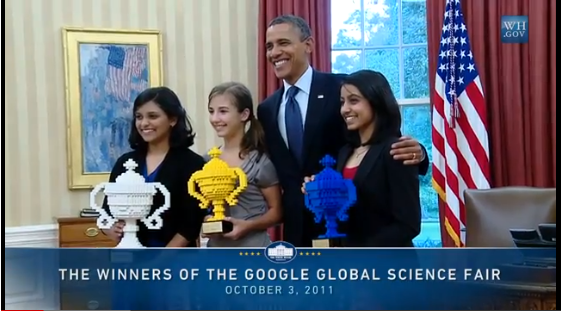Science News
Science Girl Power

by Eileen Harrington
What do ovarian cancer, asthma, and grilled chicken have in common? All three were the subject of the winning projects in the first ever Google Science Fair. The fair, created in partnership with CERN, LEGO, Scientific American, and National Geographic, received over 10,000 online entries from 91 different countries. On July 11, 2011, fifteen global finalists flew to the Google headquarters to present their projects to a panel of renowned scientists. From this pool of budding young scientists, three winners emerged—all girls!
Although the awards took place in July, the three winners had the opportunity to visit the White House a few weeks ago and present their projects to President Obama. Shree Bose, winner in the 17 -18-year-old category and the grand prize winner, investigated ways to counteract cancer cell resistance to a common chemotherapy drug, cisplatin—a drug used to treat ovarian cancer. The winner in the 15-16-year-old category, Naomi Shah, studied the effects of air quality on lungs, particularly for people with asthma. Lauren Hodge won in the 13-14-year-old category for her project that examined ways to decrease the production of carcinogenic compounds when grilling meats—she discovered that certain marinades (like brown sugar and lemon juice) worked the best. The girls found that the President genuinely showed an interest in learning more about their projects and reiterated his commitment to providing opportunities to increase the participation of all young people, particularly girls, in scientific pursuits.
The fact that all three winners are girls is impressive given the reality of the dearth of women in many science and technology fields. A 2010 report published by the American Association of University Women, Why So Few? Women in Science, Technology, Engineering, and Mathematics, found that the stereotype that boys are inherently better at math and science persists today. This is just one of the societal and environmental barriers outlined in the report that have limited women’s participation in the science, engineering, and math fields. According to the report, on average, girls take more science credits than boys in high school and tend to have higher grade point averages in the sciences. Once they get to college, however, many tend not to major in science, engineering, or math. Both male and female students change their minds in college—a recent New York Times article describes overall attrition from science and engineering majors across the board—but women show a much greater propensity to drop out of science- and technology-oriented majors. In 2006, women earned only about 20% of all of the bachelor’s degrees in physics and engineering conferred in the US.
Turning the tide on this trend is a priority here at the California Academy of Sciences, demonstrated by our participation in the GirlsRISE (Raising Interest in Science and Engineering) Museum Network (GirlsRISEnet). The Academy, along with science centers across the country, serves as a regional training hub to promote professional development for informal educators and museum professionals to engage middle- and high-school girls in science and engineering—and to encourage them in pursuing these fields as a career. The Academy held a workshop this past summer for informal educators from Bay Area museums and aquaria where we shared current research on women and minorities in STEM (Science, Technology, Engineering, and Mathematics), explored hands-on activities for promoting STEM with girls and used an exhibit evaluation tool to assess how girl-friendly our exhibits are. We will be holding another workshop in 2012.
The results of the Google Science Fair and the Academy’s involvement in GirlsRISEnet remind us that our work on promoting science is not done. As Michelle Obama recently stated at an event related to women in science:
It’s about showing every child that a scientist isn’t just something you hear about in biology class, that a doctor isn’t someone you visit when you’re sick. Instead, young people—particularly our girls—need to understand that doctors and scientists are something that anyone can become, no matter how much money your family has, no matter where you come from or whether you’re a man or a woman. And that message is more important than ever in today’s world.
As my husband has said again and again, in order to meet the challenges of the next century, we have got to strengthen our role as the world’s engine of scientific discovery and technological advancement. We need to educate the scientists who will make the next big discoveries that will fuel our economy. We need the highly skilled leaders who can teach in our classrooms, run our laboratories, and power our industries for decades to come.
And if we’re going to out-innovate and out-educate the rest of the world, then we have to open doors to everyone. We can't afford to leave anyone out. We need all hands on deck. And that means clearing hurdles for women and girls as they navigate careers in science, technology, engineering and math.
Eileen Harrington is the Academy’s Naturalist Center manager and reference librarian.